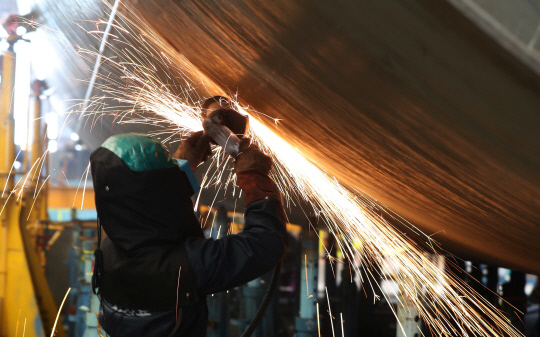Korean shipyards reported sluggish shipbuilding in the first quarter of 2024 compared to 2023, with the increasing proportion of low-skilled foreign workers being the main reason for this, according to Korea Shipbuilding Corporation (KSC). At the same time, the Korean shipbuilding industry also faces the difficult task of improving production efficiency while preventing safety accidents under the Serious Accident Punishment Law. However, so far this year, South Korea’s large and small shipyards have suffered fatal production accidents.

According to Clarkson, a British shipbuilding and shipping market analyst, new ship deliveries by South Korean shipbuilders in the first quarter of this year amounted to 2.48 million compensated gross tonnages (CGTs), down 5.7 % from the same period last year.
While the global new ship deliveries in the first quarter of this year was 8.72 million CGTs, an increase of 4.2% over the same period last year. In contrast, South Korea’s shipbuilding industry in the first quarter of this year in the shipbuilding volume declined.
South Korea’s shipbuilding industry believes that although the number of new ship orders has increased, but the shipbuilding progress has not reached the expected level, resulting in sluggish shipbuilding performance.
Researchers at the Overseas Economic Research Institute of the Export-Import Bank of Korea (KEXIM) said, “Given the current level of job security and scheduled deliveries in the shipbuilding industry, Korean shipyards need to reach at least 900,000 CGTs per month, which was not achieved in the first quarter of this year.
As the utilization rate of Korea’s large shipyards is on an upward trend, analysts believe that the increase in the ratio of foreign workers is the main factor for the decline in shipbuilding efficiency.
According to Hyundai Heavy Industries’ business report, as of the end of last year, the average utilization rate of its shipbuilding business unit was 81.3 %, up more than 5 % from 76.2 % in the first quarter of 2024. During the same period, Samsung Heavy Industries increased its utilization rate to 97% from 90%, and Hanwha Ocean improved to 97.1% from 96.4%.
The Korean industry believes that it will take some time for the country’s shipbuilding system to stabilize as the proportion of low-skilled foreign workers continues to increase, while ensuring safety.
According to MOTIE, as of the third quarter of 2023, the department has invested 14,359 people into the shipbuilding industry. Of these, foreign workers accounted for about 85.9 % reaching 12,339, with 2,020 Korean workers. Of the foreign workers with visas, 6,966 are skilled workers (E-7) and 5,737 are unskilled workers (E-9).
Researchers at the Overseas Economic Research Institute of the KEXIM noted, “It is expected that the shipbuilding system, which currently has a high proportion of foreign workers, will soon stabilize, and shipbuilding efficiency will need to be submitted while maintaining shipbuilding quality.” There are also concerns in the Korean industry that a decline in shipbuilding volume may lead to a weakening of shipbuilders’ competitiveness as shipbuilding efficiency is directly linked to shipbuilding capacity.


